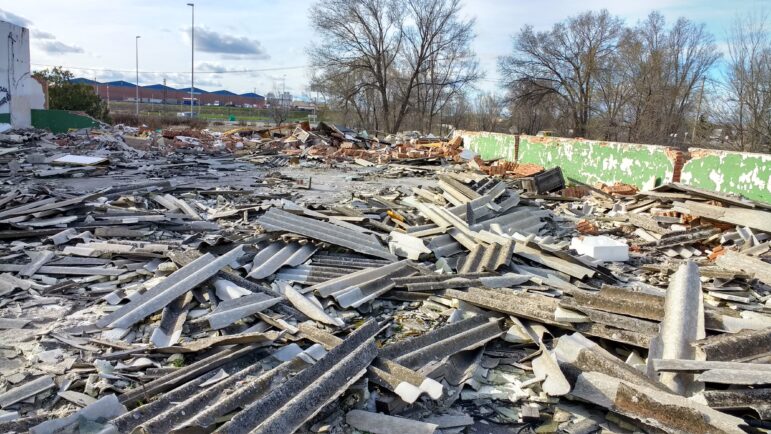Could asbestos be even more deadly than previously thought?
TAKE AWAYS
- Asbestos is more lethal than previously known. New figures, recognized by EU-institutions show that 70 000 – 90 000 Europeans die of asbestos related cancer each year.
- To older working men, a known group of victims, are now added women, teachers, hospital personal, office workers, and all people exposed to asbestos in public building and private homes.
- The death rate is rising in countries which banned the use of asbestos 30-40 years ago due to demolition and renovation of asbestos that has never been removed. An occupational disease is turning into a general health threat for all.
- European countries have a patchy knowledge of where asbestos is to be found in existing buildings and where and how asbestos waste has been dumped, an investigation in nine countries shows.
- Strategies for removal in some countries are not carried out as planned. They will at best be completed 60 – 198 years from now.
“Clouds of dust were falling on us at every blow of the truncheon, but at that time we knew nothing about asbestos,” recalled Jesús Ropero Calcerrada, a 73-year-old man who was tasked with scraping asbestos from railway carriages during his working life in Beasáin, in the Basque Country in Spain. He and others were not offered any protection from the asbestos they were removing, according to the workers’ committee.
Workers like Jesus, interviewed by Grupo Merca2, represent the most well-known group of victims of exposure to asbestos – older working men. Around 35 years ago, he and others removed the deadly mineral from wagons, armed with a truncheon and a crowbar. A year ago, he was diagnosed with mesothelioma and had to live connected up to an oxygen cylinder and received morphine for pain.
“I have a wife, look how beautiful she is, and seven grandchildren for whom I’ll put up with whatever I can. At least I hope that they get something with the compensation,” he said a few weeks ago, referring to an attempt to get a settlement with his former employer.
Jesús Ropero Calcerrada died on 5 November this year, a fortnight after he was interviewed for this investigation.
That bleak picture, of working men, drawn from heavy industries such as construction, the railways and the shipyards, is starting to change. A growing number of women have also been exposed to asbestos without knowing, and form an increasing percentage of the grim statistics.
New group of asbestos-victims

Helen Bone, a 40-year-old former nurse in Middlesbrough, England, is one of them. Last year she was diagnosed last year with the aggressive cancer, mesothelioma – tumours forming in the protective tissues that surround organs including the lungs, stomach and pelvis. The cancer is overwhelmingly linked to exposure to asbestos. Bone was exposed to asbestos in both the education and healthcare sectors, as a pupil, patient and nurse – but has never directly worked with the substance.
“I was guilty of the thinking, that this was an old man’s disease. But the more you go onto the support groups, the more you notice how many women have it now,” she tells Investigative Reporting Denmark.
Helen Bone’s case is not an isolated example. Many women like her have spent years working or studying in contaminated buildings – or even visiting them as members of the public. The presence of damaged asbestos in buildings – including shops, hospitals, schools and public buildings – is upending the traditional picture of asbestos victims.
Where once working men in heavy industry were diagnosed with cancers related to a more direct exposure to asbestos, now women in professions such as teaching, nursing and other occupations are being diagnosed, as well as young people. From a widely held perception that asbestos poses a direct occupational risk in a handful of industries, revised global figures now suggest that a once direct risk has become a diffuse risk to almost all of us.
New estimates revise deaths sharply upwards
The World Health Organisation’s (WHO) homepage refers to a global toll of asbestos deaths in 2004 of 107,000. Since then, new estimates of the global death rate from leading scientists have revised figures sharply upwards, suggesting that just under one quarter of a million people die from asbestos related disease each year.
Mesothelioma, a type of cancer which develops in the lining that protects the surface of some of the body’s organs, including the stomach, chest and pelvis, almost always linked to asbestos exposure. Other estimates for related cancers are reached by multiplying mesothelioma cases by a specific factor. In 2012 a group of scientists suggested this factor should be increased to 6.1 for exposure to one form of asbestos, chrysotile, in the paper, ‘Estimating the asbestos-related lung cancer burden from mesothelioma mortality’.
This was followed by more research by other scientists, including the 2018 study, Global Asbestos Disaster, co-authored by Dr Jukka Takala, a former president of the International Commission on Occupational Health and a leading expert on asbestos and health.

The International Labour Organisation (ILO), together with the World Health Organisation (WHO), in their first report on the Joint Estimates of the Work-related Burden of Disease and Injury (WHO/ILO Joint Estimates), published last year, come up with a slightly lower figure of 209,481 deaths linked to occupational exposure to asbestos – but which is still far higher than previous estimates.
A more alarming analysis, from the Institute of Health Metrics and Evaluation (IHME), at the University of Washington School of Medicine, suggests that as many as 90,730 deaths in the EU and the United Kingdom in 2019 (the latest year for which data is available) were linked to occupational asbestos. The global occupational rate of death for asbestos in this analysis was 239,333.
No longer just an occupational disease
These revised figures mean that the death rate from exposure to asbestos may be around twice as high as previous data had suggested – and in some countries three times as high or even more.
Using the IHME database and extrapolating estimated death rate for each country, this suggests a figure of more than 18,000 deaths for the UK, whilst official figures suggest instead an occupational death rate of around 5,000. In Denmark, health experts estimate around 400 deaths a year are linked to asbestos; the dataset suggests a figure of over 1300.
On top of that there has, according to IHME, been an alarming growth in deaths from mesothelioma in Sweden, one of the first countries to ban asbestos, with all forms banned in 1982.
Dr Takala tells Investigative Reporting Denmark he thinks the new wave of deaths is due to the asbestos still present in buildings and continuously released to the surroundings. through various work processes, such as demolition and renovations.
He adds that he expects to see a new wave of deaths in other countries where asbestos was banned later than in Sweden.
Banned – but still widely present
Asbestos was banned throughout the EU in 2005 and earlier in a number of European countries, such as Poland in 1997 and the UK, in 1999 – with news of bans tracked on the website of the International Ban Asbestos Secretariat, which is working towards a global embargo of the use of the mineral and to mitigate the damage it causes.
However, it is still present in buildings all over Europe. In homes and buildings open to the public, including hospitals, schools, museums and shops, asbestos lurks in hidden places, behind ceiling and floor tiles and mixed into cement, roofing felt and textured wall coverings as well as being readily visible on roofs, gutters and soffits as well as used to insulate boilers and pipes.
This cross-border collaboration, carried out across nine European countries, looked at the state of play across Europe regarding nation state and EU strategies on asbestos; where the deadly substance is found, how it is being dealt with and the health impacts of living with the presence of asbestos. The investigation has revealed a patchy reaction to the presence of asbestos in Europe, with different countries and federal authorities pursuing widely different policies, ranging from removal in Poland, to a so-called “management in situ” strategy in the UK.
In Europe, only the Flanders region of Belgium and Poland have developed strategies to remove asbestos from buildings. In 2017 the Dutch government proposed a ban on asbestos roofs by 2024, but its upper house, the Senate, rejected the proposal. Poland is the only EU member state with a national action plan to eradicate asbestos by 2032.
In Spain, a recent law obliges local governments to do a census of asbestos in buildings by April 2023. But the law is not entirely clear on whether private buildings should be included or not. Trade data indicate that Spain has imported more than 2.6 million tonnes of asbestos the previous century. But data is lacking on where asbestos is throughout Spain.
In Italy, estimates by the Health Ministry’s Prevention Directorate indicates it will take between 60 and 100 years to complete reclamation. Ezio Bonnano, president of the National Asbestos Observatory, believes 350 000 students in 2400 schools are exposed to asbestos. “We can say there are still no less than 40 million tonnes of asbestos in Italy,” he says. The estimate of schools containing asbestos has not shifted between 2012-2022 as new buildings with asbestos keep being discovered. The risk is therefore not declining.
In Croatia, according to estimates from non-governmental organisations, citizens have themselves changed around 40 000 asbestos roofs and facades, with some 50 000 private homes still requiring renovation. There is no data of asbestos in public buildings. Nor has neighbouring Slovenia any data on tonnage or where asbestos is to be found.
In the UK, an all party parliamentary select committee recommended a 40 year timetable to remove asbestos in buildings and to create a register of asbestos, but the government has refused to implement it.
No clear knowledge across Europe of the scale of the problem
In Flanders, figures suggest some 2.3 million tonnes asbestos in public and private buildings, as well as in utilities. Starting in November 2022 private buildings for sale built before 2001 must have an asbestos certificate, issued by certified experts, which must demonstrate that any asbestos in the building is safe. By 2032 this will be compulsory for all house owners.
In the Netherlands there is no central registration of asbestos in buildings. Administrators have been encouraged to make an inventory of asbestos in schools and hospitals. An asbestos survey is compulsory prior to demolition or removal of asbestos in buildings erected before 1994, if there is any suspicion of asbestos being present. In October 2018, the lower house, the House of Representatives, adopted a motion to make a national overview of the total number of square metres of roofs to be renovated and to specify this per municipality. In August 2022 there were still 80 million m2 of asbestos roofs in the Netherlands.
In Poland an official database estimates that there are about 14.5 million tonnes of asbestos in the country. Whilst its national asbestos removal plan has been praised, it is not actually legally binding on local regions, which are tasked to do the job. In 2010 the programme was amended which meant that even some heavily damaged roofs would not be designated as being in need of “urgent removal”.
In Denmark between 30 and 40 percent of roofs on private houses and other buildings, such as agricultural sheds, are believed to contain asbestos material. But these numbers are based on the house owners technical reports, not evaluated by experts or sampled for health reasons. There is no overall estimate of the total amount of asbestos.
In United Kingdom around six million tonnes of asbestos are believed to be contained in 210 000–400 000 buildings. 90 percent of publicly owned hospitals and 81 percent of all schools contain asbestos, Freedom Of Information requests made to the authorities by this investigation have shown there is no national register of where asbestos is to be found which is accessible to the public.
Following the Russian invasion of Ukraine, the energy crisis has refocused attention on energy saving measures, such as better insulation. However, this may mean that asbestos hidden within buildings may be removed during retrofit, which carries risks for the general public and the workers tasked with the work as fibres become airborne.
Workers put at risk

The Recovery and Resilience Facility, a major plank of an EU programme called NextGenerationEU came into force in 2021 and aims to help the EU “achieve its target of climate neutrality by 2050”, making grants and loans available to member countries worth nearly 724 billion Euros, with 37% of the funding being targeted at investment in green transition. Funding is available for renovation – but if it is carried out without clear action on worker protection whilst asbestos is removed, it could cause even more exposure to the deadly fibres.
”There’s an urgent risk that workers will be paying the price for energy saving. There are 35 million buildings – buildings that will be renovated or demolished by workers in the context of the Renovation Wave and the European Green Deal. We cannot turn our backs on them,” says Tom Deleu, general secretary of the European Federation of Building and Woodworkers, representing plumbers, wood workers, electricians and others in the construction and retrofit sectors. Many of those buildings, built before the ban on asbestos, will contain asbestos.
Asbestos has since long been acknowledged as the biggest occupational killer worldwide and the major occupational cause of cancer. The new ILO/WHO health statistics now emphasise the risks of this deadly mineral even more. They add weight to demands to change the existing occupational exposure levels (OEL) – the level of asbestos fibres in the air that can be tolerated for workers from a health perspective.
Additionally, these exposure levels are only for occupational health. There are no European-wide limits or thresholds for indoor or outdoor exposure for the general public – despite the fact that asbestos related cancers can be triggered from inhaling fibres.
The upcoming renovation wave puts focus not only on exposure levels and the lack of reliable data across most EU countries about where asbestos is found, but also on the training and certification of workers who may come into contact with it during renovation.
In addition, there has until recently been little attention focussed on what happens to asbestos once it is removed from buildings. European countries have taken very different approaches to both registering where asbestos is taken to and revealing that data. In the UK the Environment Agency has provided data to this investigation for landfills where asbestos may be taken; in Poland, a picture of both illegal and legal removal is taking shape; in Flanders it is sent to approved landfills but there is some illegal dumping as well.
Some hope is emerging as two plants that claim to vitrify asbestos, rendering it safe to be recycled, have been built in France and the UK but scaling up to meet the demand as potentially hundreds of tonnes of asbestos need to be safely dealt with will prove a challenge.
The European Parliament has considered evidence on death rates, the lack of knowledge across Europe on asbestos in situ, unregistered landfill and ambitious plans for renovation, and together with trade unions and health experts, is calling for concerted new action.
The Parliament has pushed for an ambitious new strategy – acknowledged by the Commission, which put forward more modest proposals in September. The lack of agreement by nation states and the EU means that pace, costs and strategy remain thorny issues.
In the meantime, it is ordinary people paying the price for political inaction. Helen Bone had to take medical retirement from the nursing profession.
“If I hadn’t been diagnosed, we would be a working family, paying our taxes. I loved my job; I’m going to miss it so much”.
That picture is repeated in thousands of working families across Europe, as family members cope with the diagnosis of an incurable – and avoidable – cancer.

Underestimated number of asbestos-deaths
Multifactorial effect
The most important reason for the dramatic change in the number of asbestos-deaths is the multifactorial effect, meaning if you smoke the risk for lung cancer is 10 times higher compared to non-smokers. If you are exposed to asbestos the risk is 3-5 times higher. If you both smoke and are exposed to asbestos the risk is 30-50 times higher.
Smoking increases asbestos-death
In other words if you look at 40 people, who died of lung cancer and all were smokers and exposed to asbestos only 10 of them would have died, if they only were smokers and not exposed to asbestos. The other 30 die because of the multifactorial effect of asbestos and asbestos together with smoking.
Different environments
No one is exposed to the exact same amount of smoking, asbestos and other substances. People live in different environments with a lot of combined effects. It is this knowledge that has emerged in the scientific world and have led to these new methods of estimating the deaths of asbestos – and all other diseases.
Methods
Sources for this new method of calculating deaths used by Institute for Health Metrics and Evaluation include WHO, hundreds of national authorities, and thousands of individual scientific peer-reviewed articles. Authors are from practically all over the world. The Lancet list of “Global Burden of Diseases“, which are the background for the method, includes more than 1000 scientists as contributors.
The IHME-method is described here.
The cross-border investigation, Asbestos: The Lethal Legacy, is led by Investigative Reporting Denmark, edited by Katharine Quarmby, and made in collaboration with journalists from Knack in Belgium, Tygodnik Powszechny and Reporters’ Foundation in Poland, Ostro in Croatia and Slovenia, IRPI in Italy, De Groene Amsterdammer in The Netherlands, Grupo Merca2 in Spain, Al Jazeera English in the UK and TV2 Nord in Denmark. The investigation is supported by Journalismfund.eu.
Main media-story published in EUObserver: Asbestos — two to three times more deadly than known

Pingback: Den første måned i Bruxelles: “Vi kan rykke langt mere i EU, end vi nogensinde kommer til i Danmark” - Enhedslisten.EU